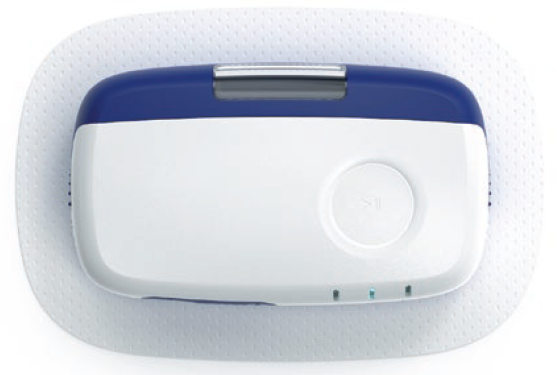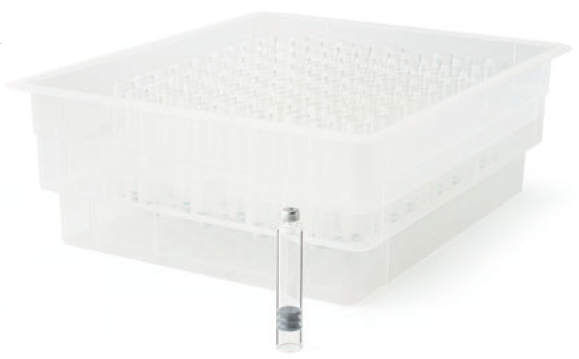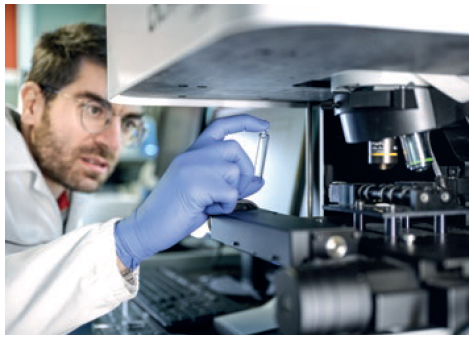To Issue 137
Citation: Golfetto P, Moberg S, “Developing an On-Body Platform for Effective Post-Operative Pain Management”. ONdrugDelivery, Issue 137 (Sep 2022), pp 48–51.
Paolo Golfetto and Sheldon Moberg discuss a collaboration between Stevanato Group and Bexson Biomedical that meets an urgent unmet patient need.
“The partnership was established to create a discreet wearable device that can safely and conveniently allow patients to manage acute pain.”
Medical operations are generally initiated to save lives, repair trauma or improve quality of life. But there is no escaping the fact that medical procedures also carry inherent risk to patients, with the potential to trigger undesirable outcomes.
Post-operative pain is a case in point. In the immediate aftermath of surgery, patients commonly experience acute pain for days – and sometimes weeks – as bones, tissues and muscles repair the damage that stems directly from surgical procedures, as well as the initial triggering trauma.
Data from multiple hospital sites across the UK shows that, within 24 hours of surgery, around half of patients report moderate levels of pain, while around a fifth experience severe pain.1 For patients in these circumstances, opioids have become a common source of prescribed relief. Over time, however, their benefits have been counterbalanced by a growing body of evidence around the potential for harm. Opioids, after all, are highly addictive, and long-term use increases the risk of developing tolerance, leading patients to high-dose dependency and substantial risk of overdose and death. Pain signalling often gets worse over time with opioid therapies. As such, even with appropriate medical care and sincere attempts to taper opioid use, many patients graduate to long-term addiction and chronic drug abuse.
In the US, this situation has been described as a national crisis, with the National Institute on Drug Abuse reporting that opioid abuse affects more than two million Americans, and an average of 90 deaths from opioid overdose every day.2 Statistics such as these have led to greater attention being paid to opioid alternatives in pain management. One such example is ketamine, which has been shown at low doses to have analgesic effects through its properties as a non-competitive N-methyl-D-aspartate receptor antagonist.3 In contrast to opioids, treating acute pain directly with ketamine stimulates a secondary action that appears to ratchet down chronic pain signalling over time.
As a controlled drug, the use of ketamine is carefully managed in medical settings by healthcare professionals, and administration is typically via on-site infusion at a clinic or hospital. While this ensures appropriate steady-state plasma levels can be achieved, the associated procedural burden and cost prevents patients managing their own pain relief from the comfort of their own home.
A MEETING OF MINDS TO MEET A SPECIFIC NEED
In 2020, Stevanato Group and Bexson Biomedical announced a collaboration designed to address these limitations and further unlock ketamine’s potential as a patient-managed pain-relief treatment. The partnership was established to create a discreet wearable device that can safely and conveniently allow patients to manage acute pain. It was founded on the combined promise of Bexson’s proprietary subcutaneous ketamine formulation, BB106, and Stevanato Group’s broad, integrated capabilities in drug delivery, drawing specifically on the potential for the company’s existing wearable device platform to be modified for the delivery of a pain-management therapy.
Constituting a disposable pod and handheld controller, this existing platform was originally developed as an alternative to pen injectors for diabetes patients, providing a comfortable, intuitive route for administering multiple subcutaneous drug therapies. On this basis, with appropriate customisation it could evolve to become a convenient and secure device for self-administration of Bexson’s proprietary ketamine formulation.
However, it was clear from the outset that a wide range of important considerations would have to be accommodated to realise the shared ambitions of both parties successfully. These considerations included explicit requirements relating to the medicine’s delivery, device manufacture and patient use. Resolving these issues in a timely fashion would be essential to limit the overall development cycle, reduce time-to-market, manage risk and contain costs.
The resulting flagship product is designed to support patients experiencing post-operative pain with a wearable device capable of administering ketamine-related pain-relief for up to five days after a procedure (Figure 1). A low-dose, continuous infusion of the therapy would establish an appropriate analgesic effect by addressing the short half-life of ketamine through the pump delivery profile. In addition, patients would have access to bolus doses for pain flares, with time-limited lockouts to avoid excessive dosing.

Figure 1: The first form factor used for initial usability studies (for illustration purposes only).
Given ketamine’s status as a controlled drug, a key consideration was to find a balance between the available volume of ketamine, dosing control parameters and design elements capable of ensuring patient safety. This meant that the device would need to accept a preloaded drug cartridge, while offering precise dosing delivery increments and consistent flow rate. At the same time, the drug-containment mechanism would need to be both tamper proof and tamper evident, to protect against potential instances of misuse.
The Collaborative Evolution of an Existing Technology Platform to Address Post-Operative Pain Challenges
The nature of the partnership between Stevanato Group and Bexson Biomedical was a critical factor in ensuring these various challenges could be successfully and efficiently resolved. While some partnerships simply describe a mutual agreement between aligned stakeholders, in the case of this project, both parties contributed proactively and equally to an integrated, open collaboration. By elevating the relationship from a transactional supplier-client level to a more involved partnership, Stevanato Group and Bexson Biomedical laid positive foundations from which tangible operational gains could be realised.
For example, at the early stages of the project, Stevanato Group worked closely with Bexson Biomedical, providing space and time to develop an extensively detailed, nuanced understanding of the patient’s experience and their needs. With deeper knowledge of the device requirements and the potential points of friction that could exist within user scenarios and manufacturing environments, Stevanato Group was afforded a significantly stronger opportunity to achieve its right-first-time delivery targets, avoiding costly complications and delays. For Bexson Biomedical, the collaboration produced a better appreciation of device capabilities and allowed the group to tailor the BB106 ketamine formulation towards a cost-effective and convenient device. Ultimately, the result of this constructive, highly engaged collaboration will be an application-specific on-body device that integrates Bexson Biomedical’s BB106 ketamine therapy based on its proprietary SEVALENT™ technology into a secure, patient-friendly drug delivery system. While it builds on many of the fundamental elements from pre-existing wearable technologies for diabetes care, a high degree of customisation ensures the specific and precise dosing requirements set out by Bexson Biomedical for its first ketamine use case are met.
As with the legacy platform, the device is based on a disposable injection unit, referred to as a pod, which is linked to a reusable electromechanical controlling unit with integrated circuitry. These elements are connected using a patented magnetic coupling system that drives the injection mechanism. The controller features a simplified user interface that incorporates activation buttons for basal and bolus dosing as well as lights and audible signalling to inform users of the start of the injection, error modes or incomplete doses. Regimens can be factory preprogrammed to adjust the dosing profile according to the patient application, and the logged user data can be transferred for use within broader healthcare support programmes.
Each pod is preloaded with a BB106 prefilled Nexa® 3 mL ISO cartridge from Stevanato Group’s broad, integrated container offerings. While ketamine does not present particular challenges with regard to viscosity or stability, precise dosing is vital in controlled release of such a pain-relief drug. This demands that the quality and geometry of the cartridge is flawlessly consistent. Stevanato Group’s rich heritage in glass expertise and market-leading position in cartridge manufacturing combine to produce the Nexa® product (Figure 2). This cartridge satisfies the stringent requirements necessary to support repeated accurate dosing with enhanced levels of mechanical resistance to withstand external forces. This system also offers the capacity to eliminate air from the drug-filled cartridges, which is a key consideration in dosing accuracy as bubbles of unpredictable size can potentially disrupt the fluid pathway and affect dosing precision.

Figure 2: The Nexa® platform features excellent mechanical resistance, offering superior compatibility with drug products and delivery devices.
At the time of administration, activation via the controller leads the pod to undergo an automatic priming function before the needle is deployed. This enables basal delivery and a limited number of patient-activated bolus deliveries based on user need. With sustainability in mind, the pod is free from electronic components, with both Stevanato Group and Bexson Biomedical committed to exploring the use of alternative materials that will further reduce the system’s impact on global warming potential targets.
“The device is highly modular and could accommodate many
other small-molecule formulations.”
A PAIN-FREE PARTNERSHIP DELIVERING PAIN RELIEF FOR PATIENTS
From the beginning of the partnership, Stevanato Group’s role as a device and manufacturing partner with integrated capabilities meant that it was able to contribute meaningfully at every stage of development, establishing a model that can scale with demand. This meant taking both direct responsibility for aspects such as container closure system characterisation, component manufacture and device sub-assembly, while also providing indirect support by advising on a suitable contract design and manufacturing organisation for the final assembly, fill and packaging phase.
The selection of a 3 mL cartridge was deliberate. This sizing allows for a small on-body device that enhances the patient experience and maximises compliance, while supporting a modular delivery system for Bexson Biomedical’s SEVALENT™ technology. Bexson Biomedical’s pharmacologic breakthrough enables liquid formulations of many small molecules at substantially higher concentration than typical intravenous presentations, while also optimising pH and osmolality to match subcutaneous tissue. The partners’ strategic collaboration will maximise the potential offered by combining a modular delivery device with new subcutaneous formulation technology capable of innovating or repurposing existing drugs and new chemical entities for delivery to this sensitive tissue.
The success of this collaborative approach between Stevanato Group and Bexson Biomedical has led to the partnership entering a newly expanded phase beyond the treatment of chronic and acute pain disorders. This phase is defined by the development of Stevanato Group’s on-body drug delivery system to accommodate additional small-molecule therapeutics from Bexson Biomedical targeted at a wide range of health conditions, including opioid overdose, benzodiazepine withdrawal, treatment-resistant depression and post-traumatic stress disorder.
The device is highly modular and could accommodate many other small-molecule formulations. At the same time, Bexson Biomedical is tailoring its formulations so that a therapeutic dose can be delivered with this type of device in mind – a 3 mL cartridge in a wearable subcutaneous infusion device. The companies’ respective technologies complement each other.
Having one partner that can manage an entire project – from container closure system to assembly technology, up to mass production – is key to bringing a device to market faster and more easily. Stevanato Group provides a range of flexible, scalable capabilities to handle device projects, whether they are delivered with Stevanato Group intellectual property or as a contract manufacturer. The company’s services range from designing, producing, testing and controlling a glass container’s integrity to the integration of such drug containment systems with device technologies for parenteral drug delivery. It offers precision injection moulding and tooling, and product development services, including automation equipment, to ensure Stevanato Group is well positioned to optimise performance of the entire system (Figure 3).

Figure 3: Stevanato Group’s integrated offering, including analytical and testing services, can help derisk pharma companies’ processes and accelerate time-to-market by ensuring right-first-time decisions.
The partners aim to deliver controlled, consistent dosing through a subcutaneous on-body drug delivery system that can be tuned to the needs of healthcare professionals in clinic and home health settings. Beyond convenience and healthcare savings, parenteral delivery can avoid gastrointestinal tract discomfort and the comparatively poor bioavailability associated with some orally administered drugs. Looking to the future, it is envisioned that further customisation of the device platform may support the dynamic delivery of a broad range of other small molecules.
From the outset, this collaboration raised the question of whether an existing wearable technology could form the basis of an entirely new device with specific, non-typical therapeutic requirements. Through the creation of an innovative new on-body device, Stevanato Group and Bexson Biomedical have not only shown this to be possible, they have also shown how approaching such a challenge with a collective, collaborative mindset can accelerate innovation, extend horizons and support the continued development of new medical treatments addressing unmet needs.
REFERENCES
- Small C, Laycock H, “Acute postoperative pain management”. Brit J Surgery, 2020, Vol 107(2), pp 70–80.
- “Opiod Abuse”. American Society of Anesthesiologists Web Page, accessed Aug 2022.
- Bell R, Kalso E, “Ketamine for pain management”. Pain Reports, 2018, Vol 3(5), p 674.
Previous article
A NEW MEMS ENGINE FOR LARGE-VOLUME SUBCUTANEOUS INJECTORSNext article
ON-BODY DELIVERY SYSTEMS – NEWS AND TRENDS
